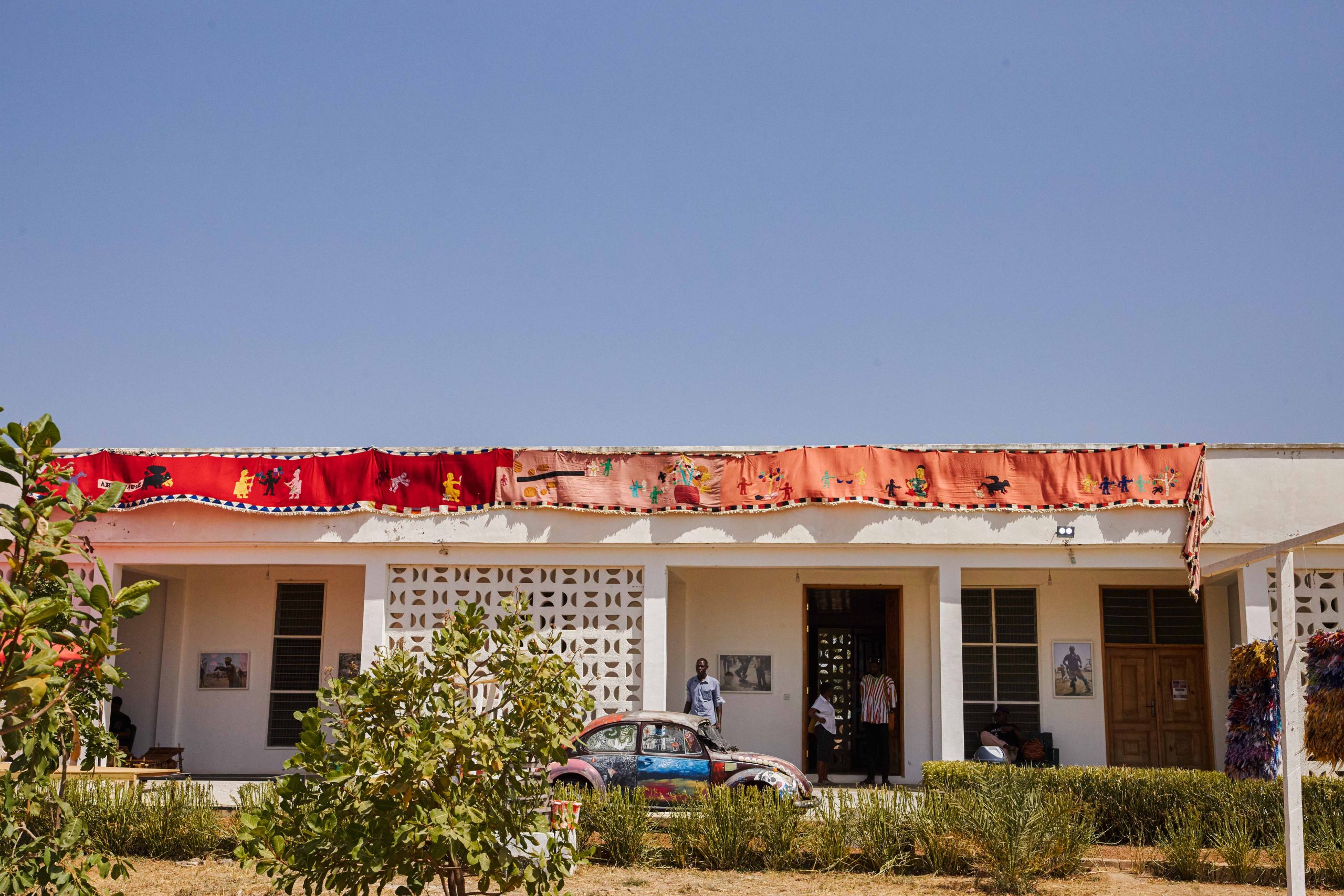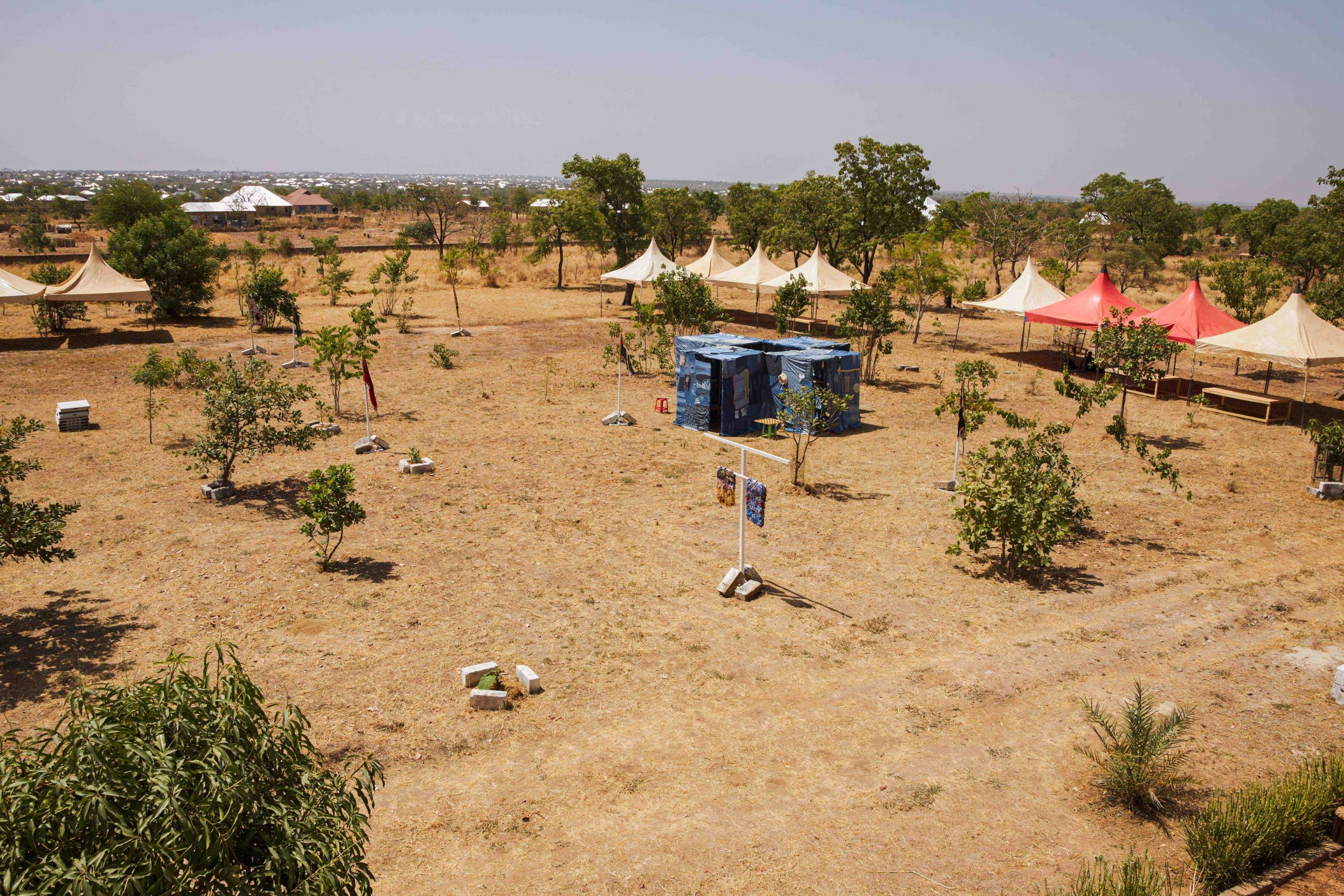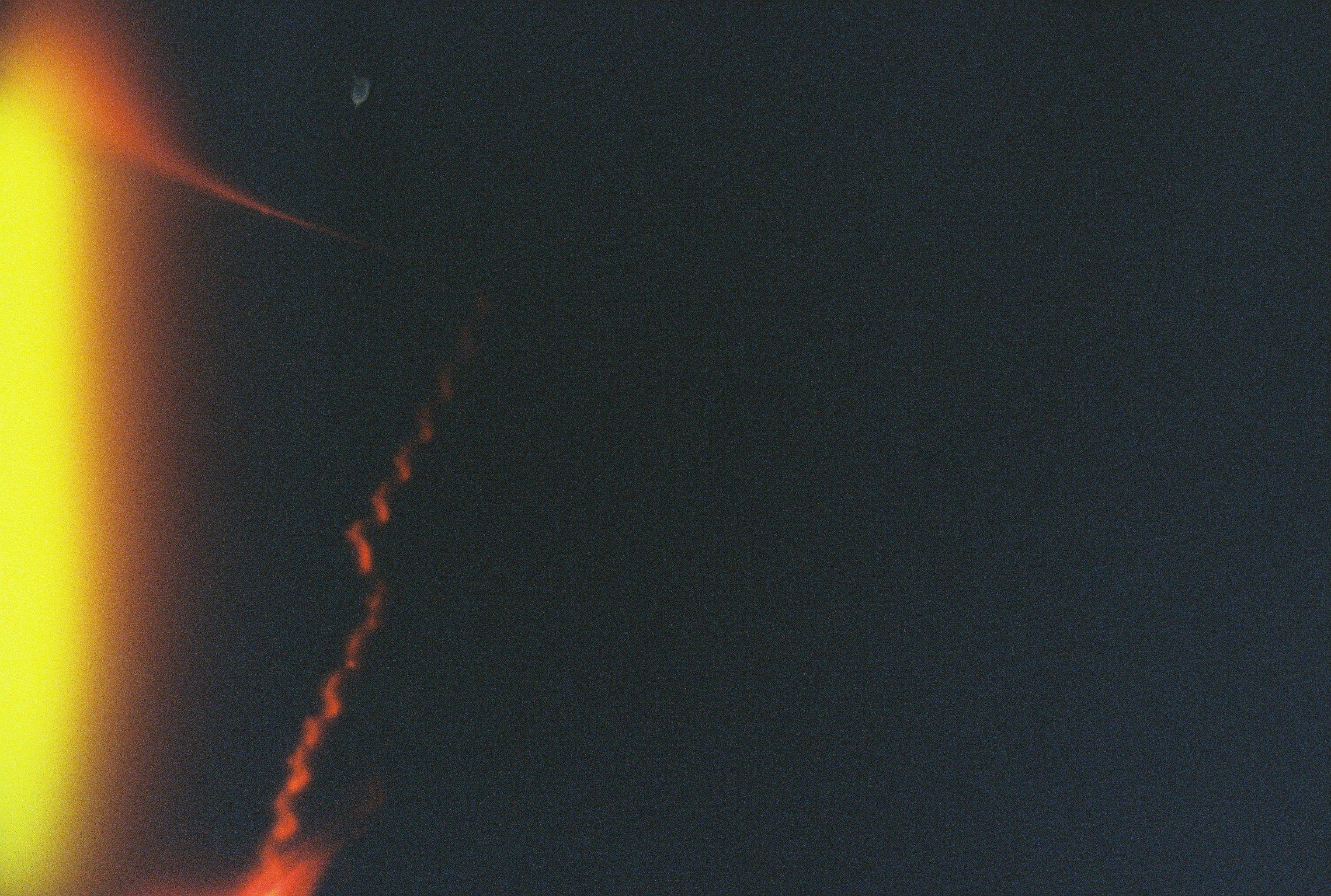Art for Development: How Independent Arts Initiatives Compensate for Government Ambivalence
August 22, 2024
Editorial, Wa, Jerusalem, Navigating Friction
August 22, 2024
Editorial, Wa, Jerusalem, Navigating Friction

A Journey
On a resting rural road, desiccated dust rises from the pressure of tyres. Earth ascends towards the sky, creating a microclimate of red clay clouds around the road, the tyres, and the passengers. A trail of red mist follows as they travel to Wa. The journey from Accra is long and mostly muted, except for the occasional glisten of verdant vegetables, tannin-dense tomatoes, and tubular yams that pepper the road. Orbs of oranges flash by, with green skin coloured by chlorophyll.
The road is a relic constructed in the late 1990s during the second term of President Jerry John Rawlings, a Ghana Air Force flight lieutenant who came into control by coup d’état in 1979. Rawlings was a staunch pan-Africanist who advocated for the Free Africa Movement, a discrete but aggressive military initiative to unify Africa and unroot neo-colonial economic reliance. The international 247-mile Kintampo-Paga road was an infrastructural translation of a pan-African desire to unify Africa through well-built routes that stimulated national trade, free movement, and better relations with neighbouring countries, including Burkina Faso.
The tyres belong to Nubuke Foundation, a Ghanaian contemporary art and cultural institution founded in 2006. Based in Accra, with a secondary site in the Upper West Region, Nubuke preserves and promotes Ghanaian culture and heritage while supporting contemporary artists and artisans.
The four passengers are Nubuke founders Odile Tevie and artist Kofi Setordji, an engineer turned driver Mr Thompson and me, a recently appointed curator for the foundation. Odile, Kofi, and Mr Thompson have been returning to the Upper West region since their first encounter over a decade ago. Like new-age disciples, they are committed to cultivating artisanal crafts and practices in the burgeoning town of Wa. Upon arrival, we are embraced by unforgiving heat, wishing we too had citrus skins coloured by chlorophyll to save soft flesh from sub-Saharan sunburn.
Destination: Wa
Wa was christened and carved into a capital in 1983 by Rawlings to summon urgent regional development. Before Rawlings, the North of Ghana was largely neglected. Despite Rawlings’s radical approach to stimulate Ghana’s economy and drive rapid urban development in the country, the growing dilemma of a crippling economy with its high inflation alongside food and power shortages once again deferred development from Northern Ghana. Since then, apart from former President John Mahama (2012–2017), successive governments have had a general ambivalence to reinvest in the region.
In place of government neglect, a sparse network of independent initiatives have emerged, trying to redress health, educational, and infrastructural concerns. In arts, education, craft and culture, initiatives like Nubuke Foundation in Wa and the Savannah Centre for Contemporary Art Tamale led by artist Ibrahim Mahama, are cultivating refreshing independent interventions. This independence garners agility and impact within local communities through the arts.

Nubuke Centre for Textiles & Clay
Nubuke Foundation completed the Centre for Textiles and Clay in 2016, a 10-acre site in Loho, on the outskirts of Wa. The Centre is focused on pottery and woven fabrics, celebrating regional hand-made textiles and ceramics while supporting the exchange of Indigenous knowledge and stimulating innovation through contemporary interpretations of traditional crafts.
An essential local community that the Centre for Textiles and Clay serves is the Wa School for the Deaf, and the Wa Methodist School for the Blind. Many children attending both schools come from the surrounding towns, often from families of small-scale farmers and market sellers. Through vocational classes in weaving, fabrics, furniture, and basket making, young people are given skills and employment opportunities to counteract the precarity they have inherited, worsened by their visual and hearing impairments. Nubuke sponsors school fees and regularly provides necessities such as uniforms, food and medication.
Nubuke’s altruism, however, is not immune to precarity. As an independent, non-partisan organisation, it faces the challenges of maintaining consistent funding to support artisans in Wa, as well as the artistic community in Accra. In response, the foundation has cultivated a relationship with an impressive international network, specifically Arts Collaboratory (AC). What Nubuke lacks in governmental infrastructure is compensated for with social capital.
Arts Collaboratory
Arts Collaboratory is an ecosystem of twenty-five diverse arts organisations in Asia, the Middle East, Africa, Latin America and Europe, addressing social change and sustainability in diverse contexts through a multiplicity of artistic practices that continuously push the boundaries of art. It connects grassroots, curatorial, activist and artist collectives to bridge different languages, cultural backgrounds, and focuses. The purpose of AC is to reimagine and generate new ways of living locally and globally through collective artistic practices. It was founded in 2007 by two Dutch foundations, Stichting DOEN and Hivos, as both a funding program and a platform for knowledge sharing between artists initiatives of the Global South. Soon after its beginnings, the Mondriaan Fund joined, supporting exchanges between the Arts Collaboratory organisations and the Dutch arts field.
For Nubuke Foundation, Arts Collaboratory provided vital yearly funding of €21,000. In parallel, a common collective pot of €600,000 was entrusted to the network to collectively decide where, when, and how to create collaborative projects and build future plans through annual assemblies that helped structure this process.
These annual Assemblies are a mechanism for the members of the network to gather physically in a destination within the network hosted by a partner organisation, to talk through challenges and issues through collective study, and to take care of each other (instead of others taking care of us). The Assemblies are organised by the members through self-governance.
Over ten days of living and working together while practising collective care, the network builds more profound empathy for each organisation’s context, and a common language to describe their universal struggles and circumstances. Regardless of geographical location, networks like Arts Collaboratory are vital in having a global perspective and understanding of the everyday struggles that independent arts initiatives worldwide are navigating. Often, at the centre of each organisation’s mission is a response and commitment to help a community primarily let down by corrupt governments, environmental precarity, historical injustice, and systems such as capitalism and or colonialism.

Assembly
In 2017, I joined Nubuke Foundation as a curator after relocating to Ghana from England. I was baptised during a visit to Wa and then attended an AC assembly. That year, the assembly was hosted by three organisations: Ashkal Alwan in Beirut, Lebanon; Al Ma’mal in Jerusalem; and RIWAQ—Centre for Architectural Conservation in Ramallah, Palestine. Members of the network evenly split between Lebanon and Jerusalem before converging mid-way in Jordan.
Attending the AC assembly for the first time in Jerusalem, Palestine, and Jordan was a seminal moment for my politics. The shift between the urgent needs of the communities in the rural Upper West region of Ghana to the experience of Palestinians radically changed my understanding of humanity and the intervention art can play as a salve to suffering.
The weight of Israel’s political power over Palestinians hung heavily in the air on the first night I arrived in Jerusalem, with a palpable sense of surveillance and its severe consequences. The first few days of the assembly were hosted in Jerusalem by Al Ma’mal, a non-profit organisation based in a former Tile Factory in New Gate, in the Old City of Jerusalem, serving the Palestinian and international arts and culture community through exhibitions, live events and workshops. Since 1998, Al Ma’mal has been a hub for art, cultural vibrancy, and learning while building bridges with the world and honouring Jerusalem’s enduring qualities as a complex, culturally rich, and ageless city.
Jerusalem was a particularly compelling and complex place to understand the relationship between Israelis and Palestinians. Unlike the segregation rife in the rest of the territory, in Jerusalem, based on census figures from 2005, About 38 per cent of the city’s residents are Palestinians, many of whom want to establish the city as their own capital. This tension over land rights was further compounded by gestures made by the US government in 2018, when they decided to relocate their embassy from the internationally recognised capital of Tel Aviv to Jerusalem, in order to endorse Israel’s claims to the city.
Today, tens of thousands of Jerusalem’s Palestinian residents live behind a concrete wall that cuts through the city. It’s part of the barrier that Israel built to keep attackers out during a wave of violence in the early 2000s. Since then, the government has been insidiously suffocating the Palestinians who live within these old walls by continuing to reshape Jerusalem, much in the same way as the country is being reshaped through the illegal spread of Israeli settlements along the West Bank. As a result, many Palestinians are struggling to maintain their foothold in the city that is their home. Those who are eventually pushed out and turn to the West Bank face even more precarity and instability. Organisations like Al Ma’mal, therefore, provide a reprieve in the city centre for Palestinians who live within the old city, as well as for Palestinians who visit Jerusalem and seek solace in a welcoming space.
I fully understood why Al Ma’mal’s very existence is a political act through an early experience during the AC Assembly. On the third night, a light festival in Jerusalem was marketed towards tourists. On the surface, it illustrated how influential and seductive organised culture can be used to express (as therapy and urgently needed exposure), and to oppress (as propaganda). The light festival left an unsavoury feeling: what better way to display political allegiance and power and mark territory than with light? It is so simple yet insidious: demarcating space with light says control and ownership of space, to be used as decided. To build, to break, to illuminate.
I carried this lesson back to Ghana as I considered how this powerful yet warped display of culture could be used for good. Running an independent art space and trying to serve local communities in a contemporary context is challenging. Still, with the support of a network like Arts Collaboratory and the initiative of the Collective Pot, it shows how collective effort and compassion for universal strife can bridge together to make a constellation of initiatives that are creating incremental change within their local ecosystems.
I write this contribution retrospectively, seven years after being introduced to the Arts Collaboratory network through Nubuke Foundation. The assembly in Jerusalem and visits to Palestine radically shifted my politics. I now write this reflection amid what the International Court of Justice ruled to plausibly be a genocide, where many people talk of the complexity of the situation – which is valid – but forget in their fear to speak; they are complicit in the eradication of a people.
Both experiences made me understand how imperative it is for art to take a political stance and prioritise the position of humanity. In the same way that Nubuke Wa helps local artisans in the north who have historically experienced disenfranchisement, the various other organisations that contribute to AC, like Al Ma’mal and RIWAQ, are helping communities by working in a trans-local way. In many global contexts, this is something that extends far beyond what governments and local authorities can provide.